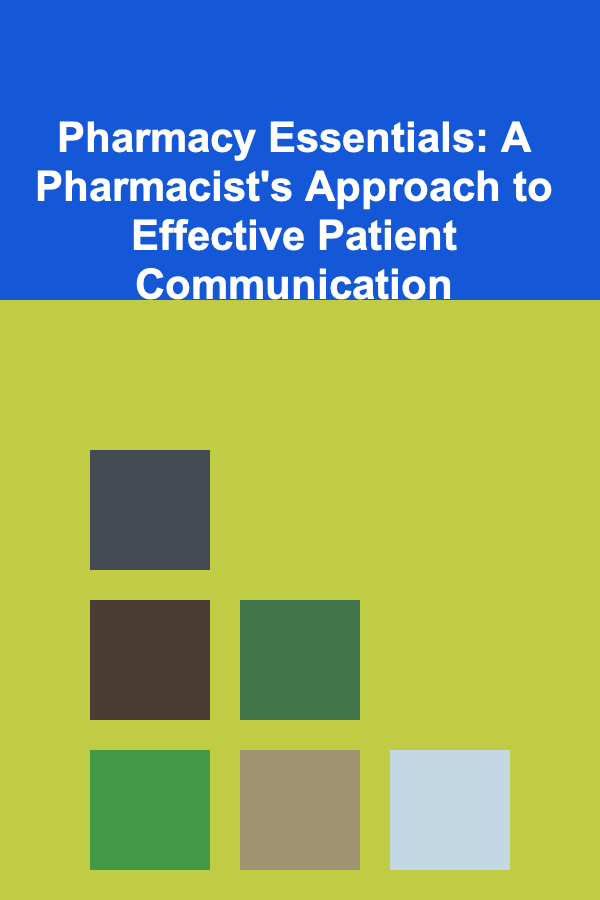
Pharmacy Essentials: A Pharmacist's Approach to Effective Patient Communication
ebook include PDF & Audio bundle (Micro Guide)
$12.99$5.99
Limited Time Offer! Order within the next:

Effective communication is a cornerstone of pharmacy practice. As pharmacists, we not only provide medications but also ensure that patients understand their treatment regimens, address their concerns, and empower them to take an active role in managing their health. Strong communication skills are critical in building trust, fostering patient compliance, and ultimately improving health outcomes.
This actionable guide will dive deep into strategies, techniques, and real-world applications that pharmacists can use to enhance their patient communication. Whether you're delivering a prescription, offering medication counseling, or responding to a patient's concerns, mastering communication can help you become a more effective healthcare provider.
Building a Foundation of Trust and Empathy
Trust is essential for a strong pharmacist-patient relationship. When patients feel that their concerns are understood and taken seriously, they are more likely to follow medical advice and adhere to their prescribed treatment regimens. Empathy is a powerful tool that can help establish this trust.
a. Active Listening
Effective communication begins with active listening. It's not enough to just hear what a patient says; you need to listen actively, understand their concerns, and respond appropriately.
Actionable Steps:
- Give Full Attention: When speaking with patients, ensure that you are fully present. Avoid distractions such as looking at your phone or computer. Make eye contact, nod occasionally, and lean in slightly to show you are engaged.
- Reflect and Clarify: When a patient expresses concerns, reflect back what you've heard. For example, "I understand that you're worried about potential side effects of this medication." This not only confirms your understanding but also reassures the patient that they are being heard.
- Ask Open-Ended Questions: Encourage patients to share their concerns by asking open-ended questions like "What has been your experience with this medication?" rather than simple yes/no questions.
b. Demonstrating Empathy
Empathy involves not only understanding a patient's perspective but also demonstrating that you care. When patients perceive that you genuinely care about their well-being, they feel more comfortable sharing their concerns.
Actionable Steps:
- Acknowledge Concerns with Compassion: If a patient expresses anxiety about a new medication or their health condition, acknowledge their feelings. For example, you might say, "It's completely understandable to feel unsure when starting a new medication."
- Provide Reassurance: Offer reassurance without dismissing their concerns. "While side effects are possible, many patients find that they subside after a few days as your body adjusts."
Simplifying Medical Jargon
Pharmacists often deal with complex medical terminology that may be difficult for patients to understand. Using simple, clear language is crucial to ensuring that patients comprehend their treatment regimens and any potential side effects.
a. Use Layman's Terms
Avoid using jargon that could confuse patients. For instance, instead of saying, "This medication is a beta-blocker that works by inhibiting the adrenergic receptors in the heart," try saying, "This medication helps your heart beat more regularly and can lower blood pressure."
Actionable Steps:
- Break Down Complex Terms: When introducing a new medication or treatment, break it down into simple steps. For example, "This pill helps reduce the swelling in your lungs, making it easier for you to breathe."
- Use Analogies: Analogies can be helpful in making complicated concepts more relatable. For example, "Think of your heart as a pump and this medication helps it pump more efficiently."
b. Confirm Understanding
After providing an explanation, always confirm that the patient understands what you've said. This can help catch any confusion early and ensure proper medication adherence.
Actionable Steps:
- Ask Patients to Repeat Information: "Can you explain how you will take this medication and when?"
- Use "Teach-Back" Technique: Ask patients to explain the instructions in their own words. This method helps gauge understanding and reinforces key points.
Addressing Concerns and Questions
Patients often come to the pharmacy with questions or concerns about their medications, and it's crucial to address them comprehensively. Whether it's a question about side effects, dosage, or interactions, providing clear and thorough answers is essential for patient safety.
a. Encourage Questions
Sometimes, patients may hesitate to ask questions due to fear of feeling uninformed. As a pharmacist, it's your role to create an environment where they feel comfortable asking anything.
Actionable Steps:
- Proactively Ask: After counseling a patient, ask, "Do you have any questions about this medication or how to take it?"
- Create an Open Environment: Encourage patients to ask about anything they might not understand by saying something like, "It's important to ask if you're unsure about any part of your treatment. I'm here to help."
b. Be Transparent About Side Effects and Risks
While it's essential to reassure patients, it's equally important to be transparent about possible side effects. This helps patients make informed decisions and prepares them for any potential reactions.
Actionable Steps:
- Discuss Possible Side Effects: When counseling, make sure to inform patients about the most common and severe side effects of their medications. For example, "Some people feel drowsy when taking this medication. If that happens, please avoid driving until you know how it affects you."
- Provide Solutions for Common Issues: If there are manageable side effects, like mild nausea, suggest practical solutions. "Taking this medication with food may help prevent stomach upset."
Fostering Medication Adherence
Medication adherence remains one of the biggest challenges in healthcare. Patients often struggle to follow their treatment regimens, whether due to forgetfulness, confusion, or misconceptions about their medications. As a pharmacist, it's important to help patients stay on track.
a. Set Realistic Expectations
When discussing a new medication, help patients set realistic expectations for how it will affect them. This includes managing their expectations regarding side effects, the time it takes for the medication to work, and the results they should expect.
Actionable Steps:
- Discuss Expected Outcomes: Let patients know how soon they should expect to feel better, but also mention that some medications take time to show results. For example, "It may take a week or two before you notice an improvement with this medication."
- Address Concerns about Medication Delays: If a medication takes time to show its full effect, be clear about this upfront. This can prevent frustration if results aren't immediate.
b. Remind and Reinforce Adherence Strategies
Pharmacists should actively remind patients about their medication regimens and provide helpful tips to make adherence easier.
Actionable Steps:
- Use Medication Calendars or Pillboxes: Recommend using pillboxes or setting up a medication calendar as a reminder to take medications consistently.
- Encourage Digital Tools: Suggest mobile apps that can remind patients to take their medications at the right times. Many of these apps also track doses and allow patients to monitor their progress.
- Regular Follow-ups: If appropriate, encourage follow-up appointments or calls to check on the patient's adherence and answer any lingering questions.
Cultural Sensitivity in Communication
A patient's cultural background can significantly influence how they perceive healthcare and medication. Understanding cultural nuances and communicating in a culturally sensitive manner can improve patient satisfaction and treatment adherence.
a. Respect Diverse Health Beliefs
Different cultures may have unique perspectives on health, wellness, and medicine. Some patients may prefer natural remedies or have beliefs that influence their willingness to take certain medications. It's important to respect these beliefs while ensuring the patient's safety.
Actionable Steps:
- Ask About Alternative Practices: If you are aware of cultural practices that may impact treatment, ask the patient in a non-judgmental way. "Are there any herbal remedies or supplements you're currently using?"
- Explain Treatment in Context: When discussing medications, frame the information in a way that aligns with the patient's cultural beliefs. For example, "I understand that you may prefer natural treatments. This medication is designed to complement your current regimen, helping you feel better."
b. Be Mindful of Language Barriers
Patients who speak a different language may have difficulty understanding complex medical information. It's essential to offer language support when necessary, such as professional translation services, or provide materials in the patient's preferred language.
Actionable Steps:
- Offer Translated Materials: If your pharmacy serves a diverse population, ensure that you have translated medication information sheets available.
- Use Professional Interpreters: If a language barrier exists, use a professional interpreter rather than relying on family members. This ensures accuracy and prevents misunderstandings.
Non-Verbal Communication
Non-verbal cues, such as body language, facial expressions, and tone of voice, can significantly affect how a message is received. Being mindful of your own body language and interpreting a patient's non-verbal signals can improve communication and prevent misunderstandings.
a. Be Aware of Your Body Language
Your own non-verbal communication can set the tone for the interaction. Maintain an open, approachable posture and ensure your facial expressions align with the message you are conveying.
Actionable Steps:
- Use Positive Body Language: Smile, maintain eye contact, and keep your posture open. Avoid crossing your arms or checking your watch, which may signal disinterest.
- Adjust Tone and Volume: Speak clearly and at an appropriate volume. A calm, reassuring tone can help patients feel more at ease.
b. Recognize Non-Verbal Cues from Patients
Watch for signs of confusion, discomfort, or anxiety in your patients. Their body language may indicate they need further clarification or are reluctant to ask questions.
Actionable Steps:
- Observe Patient Reactions: If a patient seems unsure or uncomfortable, ask if they need further explanation. For instance, "I noticed you seem unsure about the instructions. Can I explain it in more detail?"
- Encourage Open Dialogue: Create a comfortable space for patients to express any concerns or feelings that might not be verbalized.
Conclusion
Effective communication is a skill that can be honed over time. As a pharmacist, your role goes far beyond dispensing medications---you are a vital part of the healthcare team, guiding patients through their treatment journeys. By mastering patient-centered communication strategies, such as active listening, simplifying medical language, addressing concerns, fostering adherence, and respecting cultural differences, you can build strong, trusting relationships that lead to better health outcomes. Take the time to engage, educate, and empathize with your patients, and you will be better equipped to meet their needs and make a lasting impact on their health.

How to Choose the Perfect Color Palette for Your Home
Read More
How to Create and Sell Deep Learning-Driven Digital Products
Read More
How to Use the Envelope System for Better Spending Control
Read More
How To Overcome Common Learning Plateaus
Read More
How to Create Your Own Cryptocurrency on a Blockchain
Read More
How To Choose the Best Coffee for Moka Pot
Read MoreOther Products

How to Choose the Perfect Color Palette for Your Home
Read More
How to Create and Sell Deep Learning-Driven Digital Products
Read More
How to Use the Envelope System for Better Spending Control
Read More
How To Overcome Common Learning Plateaus
Read More
How to Create Your Own Cryptocurrency on a Blockchain
Read More